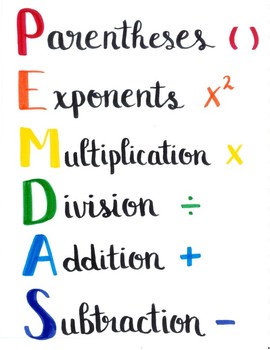mirror of
https://gitlab.com/magicalsoup/Highschool.git
synced 2025-04-03 02:31:47 -04:00
6.5 KiB
6.5 KiB
Study Sheet
Rounding and Decimals
Decimals
- Terms:
- Given the number
9123.456:- The
tenthis the4. - The
hundredthis5. - The
thousandthsis6. - The
onesis3. - The
tensis5. - The
hundredsis1. - The
thousandsis9. - Remember,
tensandtenthsmay sound the same, but they areDIFFERENT!
- The
- Given the number
- To round to a
tenth,hundredth, andthousandths- Tenths
- If the
hundredthis5or higher, round up, else, round down. - Example:
- Round
12.53223to the tenths - The answer is
12.5, as the hundredths, or3is smaller than 5.
- Round
- If the
- Hundredth
- If the
thousandthis5or higher, round up, else, round down. - Example:
- Round
12.53521to the hundredth - The answer is
12.4, as the thousandths, or5is bigger or equal to 5.
- Round
- If the
- Thousandth
- If the number of the
thousandthis5or higher, round up, else, round down.
- Example:
- Round
12.5356to the thousandths - The answer is
12.536, as the number after the thousandths, or6is bigger than 5.
- Round
- If the number of the
- Tenths
- To round to a
ones,tens,hundreds, andthousands- Ones
- If the
tenthsis5or higher, round up, else, round down. - Example:
- Round
123.5333to the ones - The answer is
124, as the tenths, or5is bigger than or equal to 5.
- Round
- If the
- Tens
- If the
onesis5or higher, round up, else, round down. - Example:
- Round
123.5777to the tens - The answer is
120, as the ones, or3is smaller than or equal to 5.
- Round
- If the
- Hundreds
- If the
tensis5or higher, round up, else, round down. - Example:
- Round
177.34343to the hundreds - The answer is
200, as the tens, or7is bigger than 5.
- Round
- If the
- Thousands
- If the
hundredsis5or higher, round up, else round down. - Example:
- Round 566.777` to the thousands
- The answer is
1000, as the hundreds, or5is bigger or equal to 5.
- If the
- Ones
Integers
Multiplication and Division
Pretend
aandbare random positive numbersType Outcome a × b Positive number a × (-b) Negative number (-a) × b Negative number (-a) × (-b) Positive number a ÷ b Positive number a ÷ (-b) Negative number (-a) ÷ b Negaitve number (-a) ÷ (-b) Positive number Treat as normal divion and multiplacation, and just add the negative sign infront of the number according to the rules above.
Practice
- 8 × -7
- Answer:
-56
- Answer:
- 2 × 4
- Answer:
8
- Answer:
- -7 × -7
- Answer:
1
- Answer:
- -10 × 4
- Answer:
-40
- Answer:
- 8 ÷ 4
- Answer:
2
- Answer:
- -16 ÷ -8
- Answer:
2
- Answer:
- -4 ÷ 1
- Answer
-4
- Answer
- 9 ÷ -3
- Answer:
-3
- Answer:
- 8 × -7
Addition and Division
Pretend
aandbare random postive numbersType Equivalent a+b a+b b+a b+a a+(-b) a-b (-a)+b b-a a-b a-b b-a b-a a-(-b) a+b (-a)-b a-b
Order Or Operation
- BEDMAS
- Follow
BEDMASfor order of operations if there are more than one operation
| Letter | Meaning |
|---|---|
| B / P | Bracket / Parentheses |
| E | Exponent |
| D | Divison |
| M | Multiplication |
| A | Addition |
| S | Subtraction |

- Follow order of operation, inorder to do know which operation to do first.
- Example: Given \(`(2+4) \times 5 - 9 \div
3`\)
- First do everything in brackets: \(`(6) \times 5 - 9 \div 3`\)
- Then do multiplication/division: \(`30 - 3`\)
- Then finally, do subtaction/addition: \(`27`\)
- The answer is
27.
Fractions / Rational Numbers
- The number on the top is called the
numerator. - The number on the bottom is called the
denominator. - A fraction in its most simple form is when the
numeratoranddenominatorcannot be both divided by the same number.
Additions / Subtractions With Fractions
- Example: \(`\frac{3}{5} + \frac{4}{3}`\)
- Find
common denominator, which is15, as5and3both are factors of15.- You can do this easily with a table, just count by the number you are using, for example:
Counting by 5s Counting by 3s 5 3 10 6 15 9 20 12 25 15 - As you can see, both columns contain the number
15, so15is the common denominator. - Now, after we find the denominator, we must convert the fraction so
that it has the
common denominator. To do this, we must multiply the denominator by a number, so that it equals thecommon denominator. For the first fracion \(`\frac{3}{5}`\), thedenominatoris5, to get to15, we must multiply it by3. Now, whatever we do on the bottom, me MUST do it on the top too, so we also multiply thenumeratorby3as well, the new fraction is now \(`\frac{3 \times 3}{5 \times 3} = \frac{9}{15}`\). - We now do the same thing to the other fraction: \(`\frac{4 \times 5}{3 \times 5} = \frac{20}{15}`\)
- Now that the denominators are the same and the fractions are
converted, we can just simply add the
numeratorstogether while keeping thedenominatorthe same. The result is \(`\frac{9 + 20}{15} = \frac{29}{15}`\). - The same steps applied to subtracion, with the only difference of subtacting the numerators rather than adding them.
Multiplaction With Fractions
- To multiply a fracion, simply multiply the
numeratorstogether, and thedenominatorstogether. - Example: \(`\frac{3}{6} \times
\frac{7}{4}`\)
- Answer: \(`\frac{3 \times 7}{6 \times 4} = \frac{21}{24}`\)
Division With Fractions
- To divide 2 fractions, flip the second fraction upside down and multiply them togehter.
- Or, in advanced terms, mulitply the first fraction by the reciporocal of the second fraction.
- Given an example: \(`\frac{4}{2} \div
\frac{6}{9}`\)
- First, flip the second fraction upside down: \(`\frac{4}{2} \div \frac{9}{6}`\)
- Then change the division to a multiply: \(`\frac{4}{2} \times \frac{9}{6}`\)
- Then multiply the 2 fractions \(`\frac{4 \times 9}{2 \times 6} = \frac{36}{12}`\)